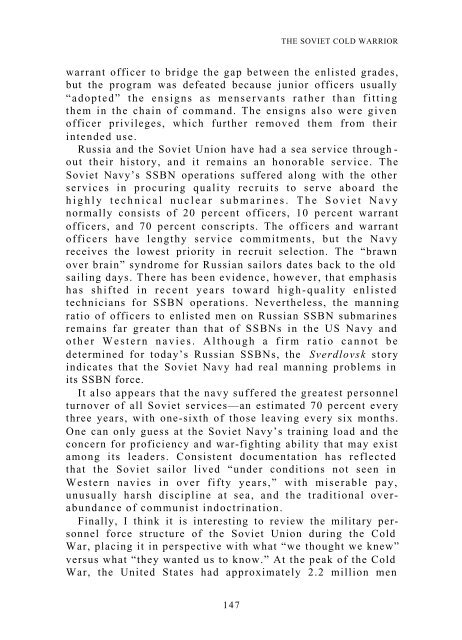You also want an ePaper? Increase the reach of your titles
YUMPU automatically turns print PDFs into web optimized ePapers that Google loves.
THE SOVIET COLD WARRIOR<br />
warrant officer to bridge <strong>the</strong> gap between <strong>the</strong> enlisted grades,<br />
but <strong>the</strong> program was defeated because junior officers usually<br />
“adopted” <strong>the</strong> ensigns as menservants ra<strong>the</strong>r than fitting<br />
<strong>the</strong>m in <strong>the</strong> chain of command. The ensigns also were given<br />
officer privileges, which fur<strong>the</strong>r removed <strong>the</strong>m from <strong>the</strong>ir<br />
intended use.<br />
Russia and <strong>the</strong> Soviet Union have had a sea service through -<br />
out <strong>the</strong>ir history, and it remains an honorable service. The<br />
Soviet Navy’s SSBN operations suffered along with <strong>the</strong> o<strong>the</strong>r<br />
services in procuring quality recruits to serve aboard <strong>the</strong><br />
highly technical nuclear submarines. The Soviet Navy<br />
normally consists of 20 percent officers, 10 percent warrant<br />
officers, and 70 percent conscripts. The officers and warrant<br />
officers have lengthy service commitments, but <strong>the</strong> Navy<br />
receives <strong>the</strong> lowest priority in recruit selection. The “brawn<br />
over brain” syndrome for Russian sailors dates back to <strong>the</strong> old<br />
sailing days. There has been evidence, however, that emphasis<br />
has shifted in recent years toward high-quality enlisted<br />
technicians for SSBN operations. Never<strong>the</strong>less, <strong>the</strong> manning<br />
ratio of officers to enlisted men on Russian SSBN submarines<br />
remains far greater than that of SSBNs in <strong>the</strong> US Navy and<br />
o<strong>the</strong>r Western navies. Although a firm ratio cannot be<br />
determined for today’s Russian SSBNs, <strong>the</strong> Sverdlovsk story<br />
indicates that <strong>the</strong> Soviet Navy had real manning problems in<br />
its SSBN force.<br />
It also appears that <strong>the</strong> navy suffered <strong>the</strong> greatest personnel<br />
turnover of all Soviet services—an estimated 70 percent every<br />
three years, with one-sixth of those leaving every six months.<br />
One can only guess at <strong>the</strong> Soviet Navy’s training load and <strong>the</strong><br />
concern for proficiency and war-fighting ability that may exist<br />
among its leaders. Consistent documentation has reflected<br />
that <strong>the</strong> Soviet sailor lived “under conditions not seen in<br />
Western navies in over fifty years,” with miserable pay,<br />
unusually harsh discipline at sea, and <strong>the</strong> traditional overabundance<br />
of communist indoctrination.<br />
Finally, I think it is interesting to review <strong>the</strong> military personnel<br />
force structure of <strong>the</strong> Soviet Union during <strong>the</strong> <strong>Cold</strong><br />
<strong>War</strong>, placing it in perspective with what “we thought we knew”<br />
versus what “<strong>the</strong>y wanted us to know.” At <strong>the</strong> peak of <strong>the</strong> <strong>Cold</strong><br />
<strong>War</strong>, <strong>the</strong> United States had approximately 2.2 million men<br />
147
















